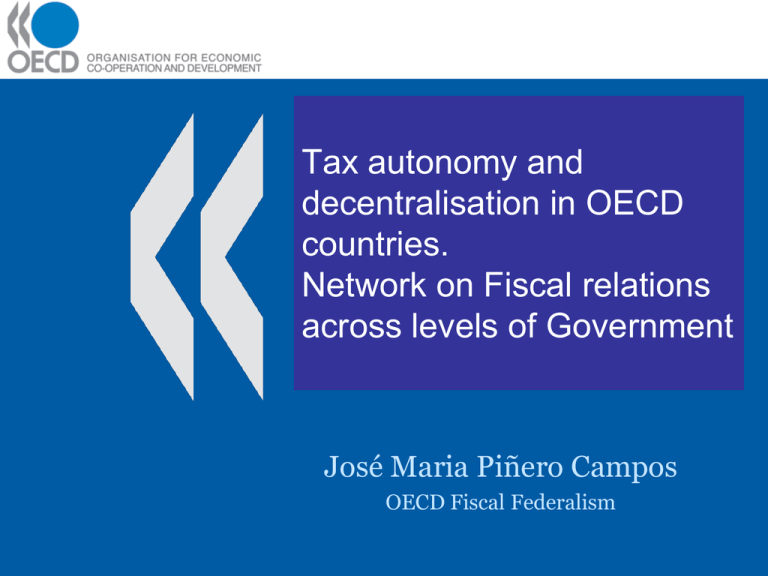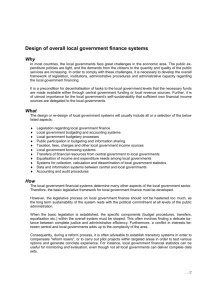Tax autonomy and decentralisation
advertisement

Tax autonomy and decentralisation in OECD countries. Network on Fiscal relations across levels of Government José Maria Piñero Campos OECD Fiscal Federalism INDEX • Tax autonomy and decentralisation – Tax decentralisation – Tax autonomy – Tax Decentralisation vs. Tax Autonomy – Tax autonomy structure – Pros and cons of tax Autonomy – Tax Autonomy and disparities – Tax autonomy and tax rate evolution • Network on Fiscal relations across levels of government – Documents – Workshops – Statistical databases – Current Tasks States/regions Municipalities Netherlands Ireland Greece United Kingdom Hungary Spain Belgium Luxembourg Korea Portugal Germany Norway Japan Italy France Finland Czech Republic Denmark Switzerland Austria Sweden Austria Switzerland United States Spain Canada Germany Belgium Tax Decentralisation % of total revenues 80 70 60 50 40 30 20 10 0 States/regions Municipalities Ireland Austria Czech Republic Greece Netherlands United Kingdom Hungary Portugal Germany Korea Italy Belgium Spain Luxembourg France Japan Norway Finland Denmark Switzerland Sweden Austria Germany Belgium Spain Switzerland United States Canada Tax Autonomy % of total revenues 70 60 50 40 30 20 10 0 Tax Decentralisation vs. Tax Autonomy Autonomous tax revenues (% of Total revenues) 70 65 Sweden LOC Canada STA 60 Switzerland STA 55 Switzerland LOC United States STA Denmark LOC Finland LOC 50 45 Norway LOC 40 Japan LOC 35 Spain LOC 30 Luxembourg LOC Belgium LOC France LOC Italy LOC Spain STA Korea LOC Germany LOC 25 20 Hungary LOC 15 Portugal LOC United Kingdom LOC Netherlands LOC Greece LOC 10 5 0 0 Ireland LOC 10 20 Czech Republic LOC 30 40 Austria STA 50 Germany STA Austria LOC 60 70 Tax revenues (% of Total revenues) Ideal Tax autonomy structure • Taxes which are growth-enhancing at sub-central level are the same as the ones which are growth-enhancing at central level • But, there are some additional requirements : – – – – – Link between taxes paid and public services received SCG Taxes should be non-mobile Non redistributive Non cyclical Tax base should be evenly distributed across jurisdictions Ideal Tax autonomy structure • Property Taxes • Personal Income Taxes – redistributive • Consumption Taxes. – Divert taxes among jurisdictions • Corporate Income Taxes – Highly cyclical, – Geographically concentrated States/regions Municipalities Ireland Austria Czech Republic Greece Netherlands United Kingdom Hungary Portugal Property Germany Italy Korea Belgium PIT Spain Luxembourg Consumption France Japan Norway Finland Denmark CIT Switzerland % of total revenues Sweden Austria Germany Belgium Spain Switzerland United States Canada Real Tax autonomy structure Others 70 60 50 40 30 20 10 0 Pros and cons or Tax autonomy • Pros – Make governments more responsive to citizens’ tastes and preferences – Improve budget management efficiency. A more reduced size of subcentral governments have been reported (Rodden (2003), Fiva (2006), Sorens (2008)) – Promote democratic accountability – Provide incentives for growth-oriented economic and fiscal policies – Could reduce disparities when small jurisdictions could benefit from bigger neighbour jurisdictions • Cons – Could increase disparities. If equalisation is not enough poorer jurisdictions could be obliged to do a bigger effort – Could deteriorate SCG revenues (race to the bottom). – Could deteriorate SCG fiscal stability, if it is based on more volatile taxes as Corporate or consumption taxes Tax Autonomy and disparirites. What happen when equalisation is small?: Implicit tax rate (in % of average) 200 180 Implicit tax rate (in % of average) 200 CANADA S/R SWITZERLAND S/R 180 2006 160 160 140 140 120 120 1997 100 100 80 80 60 60 40 40 20 20 0 0 0 30 60 90 120 150 180 210 240 270 2006 1998 0 300 30 60 90 120 150 Tax raising capacity per capita (in % of average) Implicit tax rate (in % of average) 200 2007 180 Tax rate (in % of Regional average) 200 FRANCE (Departments) 180 210 240 270 300 Tax raising capacity per capita (in % of average) CASTILLA LA MANCHA (Municipios de más de 10.000 hab.) 180 160 160 140 140 2002 120 120 100 100 80 80 60 60 40 40 20 20 0 0 0 30 60 90 120 150 180 210 240 270 300 Tax raising capacity per capita (in % of average) 0 30 60 90 120 150 180 210 240 270 300 Tax raising capacity per capita (in % of average) Tax Autonomy and disparirites. What happen when equalisation is high?: Implicit tax rate (in % of average) 200 Implicit tax rate (in % of average) 200 DENMARK LOC 180 FINLAND LOC 180 160 160 140 140 1997 120 1997 120 100 100 2007 80 2007 80 60 60 40 40 20 20 0 0 30 60 90 120 150 180 210 240 270 300 0 0 Tax raising capacity per capita (in % of average) CIT and Property tax (CA or IMI) Implicit tax rate (in % of average) 200 90 120 150 180 210 240 270 300 Tax raising capacity per capita (in % of average) SWEDEN LOC 180 160 160 140 140 120 120 2002 100 1997 100 2007 80 60 Implicit tax rate (in % of average) 200 PORTUGAL LOC 180 30 2007 80 60 60 40 40 20 20 0 0 0 30 60 90 120 150 180 210 240 270 300 Aggregate tax base per capita (in % of average) 0 30 60 90 120 150 180 210 240 270 300 Tax raising capacity per capita (in % of average) Tax Autonomy and disparirites. What happen when equalisation is very high?: Implicit tax rate (in % of average) 200 SPAIN (Regions) 180 160 140 2006 120 100 1997 80 60 40 20 0 0 30 60 90 120 150 180 210 240 270 300 Tax raising capacity per capita (in % of average) Tax autonomy and Tax rate evolution CANADA Implicit tax rate (%) 78.0 77.0 76.0 75.0 74.0 73.0 1997 1998 1999 2000 2001 2002 2003 2004 2005 2006 2007 2004 2005 2006 2007 SWITZERLAND Implicit tax rate (%) 15.0 14.0 13.0 12.0 11.0 10.0 1997 1998 1999 2000 2001 2002 2003 FRANCE (Regions) Taxe fonciere Taxe profesionale 5.0 4.0 3.0 2.0 1.0 0.0 1997 1998 1999 2000 2001 2002 2003 2004 2005 2006 2007 Tax autonomy and tax rate evolution, an ideal evolution? Taxe foncière sur les propriétés bâties mean mean - stdev mean + stdev 5.00 4.00 3.00 2.00 1.00 0.00 1987 1988 1989 1990 1991 1992 1993 Taxe foncière sur les propriétés non bâties 1994 1995 mean 1996 1997 1998 mean - stdev 1999 2000 2001 2002 2003 2004 2005 2006 2007 2008 2001 2002 2003 2004 2005 2006 2007 2008 2001 2002 2003 2004 2005 2006 2007 2008 mean + stdev 12.00 10.00 8.00 6.00 4.00 2.00 0.00 1987 1988 1989 1990 1991 1992 1993 1994 1995 mean Taxe profesionnelle 1996 1997 1998 mean - stdev 1999 2000 mean + stdev 5.00 4.00 3.00 2.00 1.00 0.00 1987 1988 1989 1990 1991 1992 1993 1994 1995 1996 1997 1998 1999 2000 OECD Network on Fiscal relation across levels of government • Created in 2003 and managed by 3 OECD Directorates: – Tax Policy and Administration (CTP) – Economics Department (ECO) – Directorate for Public Governance and Territorial Development (GOV) • Providing OECD countries with the analytical and statistical underpinnings for decisions on how to organise the relationships among central, regional and local governments • A high level, multidisciplinary policy dialogue platform, between policy makers for taxation and expenditure. • Participants: – 17 OCDE countries, – 25 countries are providing statistical data and policy information – The International Monetary Fund, the World Bank, the Council of Europe and the European Commission participate in the Network Fiscal Network. Documents • Fiscal policy across levels of government in times of crisis • Explaining the Sub-National Tax-Grants Balance in OECD Countries • Finding the Dividing Line between Tax Sharing and Grants: A Statistical Investigation • The Fiscal Autonomy of Sub-Central Governments: An Update • The Spending Power of Sub-Central Governments: A Pilot Study • Taxes and Grants: On the Revenue Mix of Sub-Central Governments • Market Mechanisms in Sub-Central Public Service Provision • Promoting Performance: Using Indicators to Enhance the Effectiveness of Sub Central Spending • Fiscal Equalisation in OECD countries • Intergovernmental transfers and decentralised public spending • Fiscal autonomy of sub-central governments • Fiscal rules for sub-central governments: design and impact Fiscal Network. Workshops • Tax competition at Sub-central level. Bern, May-June 2010 • Economic Crisis and Sub-central Fiscal Policy. Paris, June 2009 • Taxes versus Grants. Vienna, May 2008 • Fiscal Equalisation in OECD Countries. Zaragoza, June 2006 • The Efficiency of Sub-central Spending. Paris, May 2006 Fiscal Network. Statistical database • Intergovernmental transfers: update of National Accounts data • Taxing power of local and regional governments in OECD countries • Revenue structure of sub central government • Intergovernmental grants Fiscal Network. Current tasks • Reforming Fiscal Relations across Levels of Government: – the way in which political and institutional factors influence the design, decision-making process, adoption and long-term implementation of fiscal federal reforms. – Two kind of results are foreseen: • A summary report with the basic elements to task into account when reforming fiscal relations • Some country case analysis • Sub-Central Tax Competition: – What means tax competition at sub-central level? – What impact has the tax competition? – What are the potential framework conditions to make it beneficial for fiscal policy and fiscal outcomes? Seminar about Fiscal decentralisation of Public Administrations Cartagena, 2-6 November 2010 In collaboration with Instituto de Estudios Fiscales • To share Spain and OECD knowledge in fiscal federalism • To create a policy dialog platform about the most relevant trends and the exchange of experienceies and information about regional and local financing, fiscal rules and budgetary discipline The inscription is open till 24th September in the Centro de Formation de la AECID de Cartagena de Indias webpage: http://www.aecidcf.org.co/aeci_cartagena/on_line/ Seminar about Fiscal decentralisation of Public Administrations Cartagena, 2-6 November 2010 ISSUES • Sub-central governments financing: Basic principles. Tax financing and transfer financing. International existing models. • Taxes as financing source of sub-central governments. Taxes adequate for decentralisation. Tax decentralisation and tax autonomy. Consequences of tax decentralisation. Tax competition. Equalisation • Fiscal decentralisation and budgetary stability. Budgetary consolidation. Sub central governments debt. • Management of a fiscal decentralised system. Responsibilities distribution. Principles: institutional loyalty and co-ordination, transparency, etc. Decentralized public services provision. Indicators, market mechanisms in the provision of public services. The new technologies.





